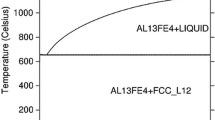Abstract
By using newly constructed high-pressure gas atomization equipment, the effect of atomizing gas (Ar, N2, or He) on the formation tendency of amorphous alloy powders and their Curie temperature(T c ), structural relaxation, glass transition(T g ), and crystallization(T x ) was examined for Fe-P-C, Fe-Si-B, Fe-Cr-Mo-P-C, Co-Si-B, Ni-Si-B, Ni-Pd-P, and Cu-Zr alloys with easy glass-forming capacity. Amorphous powders are formed in all the alloy systems and the critical diameter for the formation of amorphous powders is 25 to 44 µm for Ar and 44 to 100 µm for He. The average particle size is considerably smaller for He than for Ar and N2, probably because of large kinematic viscosity of He. No appreciable differences inT c ,T g , andT x of Fe77P13C10 amorphous powders with the kind of atomizing gas are seen and these values are the same as those of the amorphous ribbon with 20 µm thickness. However, He-atomized Fe77P13C10 powders exhibit a lower onset temperature of relaxation and larger heats of relaxation and crystallization as compared with the Ar- and N2-atomized powders, and the values of the He-atomized powders are comparable to those of the ribbon sample, indicating that He-gas atomization has a higher cooling capacity and results in the formation of a more disordered amorphous structure. This difference agrees with the tendency estimated under the assumption that heat removal from atomized droplets occurs by Newtonian cooling caused only by the convective heat transfer. Accordingly, the greater heat removal capacity of He gas is concluded to be a dominant factor for the formation of amorphous alloy powders with a more unrelaxed atomic configurations.
Similar content being viewed by others

References
A. Inoue, H. S. Chen, J.T. Krause, and T. Masumoto:J. Non-Cryst. Solids, 1984, vol. 61/62, p. 949.
A. Inoue, H. S. Chen, J. T. Krause, T. Masumoto, and M. Hagiwara:J. Mater. Sci., 1983, vol. 18, p. 2743.
A. Inoue, N. Yano, and T. Masumoto:J. Mater. Sci., 1984, vol. 19, p. 3786.
S. A. Miller and R. J. Murphy:Scripta Metall., 1979, vol. 13, p. 673.
S.A. Miller and R. J. Murphy:Rapid Solidification Processing, Prin- ciples and Technologies II, R. Mehrabian, B.H. Kear, and M. Cohen, eds., Claitor's Publishing Division, Baton Rouge, LA, 1980, p. 385.
N.J. Grant:Rapid Solidification Processing, Principles and Technologies, R. Mehrabian, B.H. Kear, and M. Cohen, eds., Claitor's Publishing Division, Baton Rouge, LA, 1977, p. 230.
V. Anand, A. J. Kaufman, and N. J. Grant:Rapid Solidification Processing, Principles and Technologies II, R. Mehrabian, B. H. Kear, and M. Cohen, eds., Claitor's Publishing Division, Baton Rouge, LA, 1980, p. 273.
A. Lawley:J. Metals, 1981, vol. 33, p. 13.
U. Backmark, N. Backstrom, and L. Arnberg:Powd. Met. Inst., 1986, vol. 18, p. 338.
G. Rai, E. Lavernia, and N.J. Grant:J. Metals, 1985, no. 8, p. 22. U.M. Hagiwara, A. Inoue, and T. Masumoto:Metall. Trans. A, 1981, vol. 12A, p. 1027.
M. Hagiwara, A. Inoue, and T. Masumoto:Sei. Rep. Res. Inst. Tohoku Univ., 1981, vol. 29A, p. 351.
M. J. Couper and R.F. Singer:Rapidly Quenched Metals, S. Steeband H. Warlimont, eds., Elsevier Science Publishers B.V., Amsterdam, 1985, p. 1737.
H. S. Chen:Amorphous Metallic Alloys, F. E, Luborsky, ed., Butter- worth's, London, 1983, p. 169.
A. Inoue, H. S. Chen, and T. Masumoto:J. Non-Cryst. Solids, 1984, vol. 61/62, p. 949.
A. Inoue, T. Masumoto, and N. Yano:J. Mater. Sci., 1984, vol. 19, p. 3786.
A. Perel, J.F. Mahoney, B.E. Kalensher, K. E. Vickers, and R. Mehrabian:Rapid Solidification Processing, Principles and Tech- nologies, R. Mehrabian, B.H. Kear, and M. Cohen, eds., Claitor's Publishing Division, Baton Rouge, LA, 1977, p. 258.
R. Mehrabian:Rapid Solidification Processing, R. Mehrabian, B. H. Kear, and M. Cohen, eds., Claitor's Publishing Division, Baton Rouge, LA, 1977, p. 9. $
Author information
Authors and Affiliations
Rights and permissions
About this article
Cite this article
Inoue, A., Masumoto, T., Ekimoto, T. et al. Preparation of Fe-, Co-, and Ni-Based amorphous alloy powders by high-pressure gas atomization and their structural relaxation behavior. Metall Trans A 19, 235–242 (1988). https://doi.org/10.1007/BF02652531
Issue Date:
DOI: https://doi.org/10.1007/BF02652531



